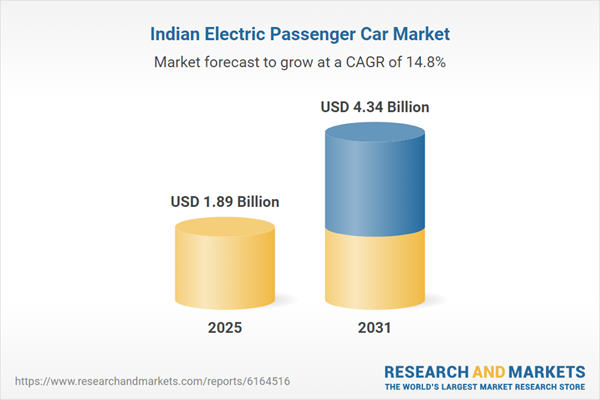Speak directly to the analyst to clarify any post sales queries you may have.
10% Free customizationThis report comes with 10% free customization, enabling you to add data that meets your specific business needs.
Vehicle manufacturers are launching multiple models across price ranges, expanding access to electric passenger cars in different consumer segments. For instance, in 2024, India's electric vehicle (EV) industry achieved a significant milestone, with sales increasing by 26.5% year-on-year to 1.94 million units, according to Vahan data from the Ministry of Road Transport and Highways. This growth elevated the country's EV penetration to 7.46%, up from 6.39% in 2023. Despite this progress, traditional petrol vehicles remain dominant, comprising 73.69% of the 26.04 million vehicles sold in 2024. The average number of petrol, diesel, CNG, or hybrid vehicles sold per EV improved to 12.43, compared to 15.67 in 2023 and 21.05 in 2022.
Market Drivers
Government Incentives and Regulatory Push
Government policies are a cornerstone of electric vehicle expansion in India. Schemes such as FAME (Faster Adoption and Manufacturing of Electric Vehicles), tax reductions on electric vehicles, and exemptions from road registration fees directly reduce the ownership cost for consumers. These incentives extend to manufacturers as well, offering production-linked benefits and import duty relaxations on key components like lithium-ion cells and motors. Regulatory frameworks are also tightening for traditional fuel vehicles, indirectly encouraging a shift to EVs. Mandated fuel efficiency standards and emission norms are pushing OEMs to invest more in electric platforms.Key Market Challenges
Inadequate Charging Infrastructure
The availability of charging stations remains a major barrier to electric passenger car adoption. Despite ongoing development efforts, the density and accessibility of chargers are not sufficient to meet rising demand. Charging infrastructure is concentrated in urban centers, leaving highways and smaller towns underserved. The lack of standardized connectors, variable charging speeds, and fragmented payment systems further complicate the user experience. Many residential complexes lack dedicated EV charging provisions, making home charging difficult for a significant portion of the population. Public chargers often suffer from downtime, poor maintenance, or lack of real-time availability tracking, reducing user confidence.Key Market Trends
Emergence of Battery Swapping Models
Battery swapping is emerging as a promising solution to reduce EV downtime and eliminate range anxiety. This model involves replacing a depleted battery with a fully charged one at designated stations, offering a faster alternative to traditional charging. It is especially beneficial for fleet operators, delivery services, and taxis that operate on tight schedules. The modularity of the system allows better battery utilization and centralized charging, which optimizes energy usage. Subscription-based models separate the battery cost from vehicle ownership, reducing the upfront price and making electric passenger cars more accessible. Battery health can be monitored centrally, improving safety and longevity. Swapping infrastructure requires standardization across vehicle types, which is gradually being implemented through industry partnerships.Key Market Players
- Maruti Suzuki India Limited
- Tata Motors Limited
- Mahindra & Mahindra Limited
- Hyundai Motor Company
- Honda Motor Company, Ltd.
- Audi AG
- BMW India Pvt Ltd
- MG Motor India Pvt. Ltd.
- Toyota Motor Corporation
- Ford Motor Company
Report Scope:
In this report, the India Electric Passenger Car Market has been segmented into the following categories, in addition to the industry trends which have also been detailed below:India Electric Passenger Car Market, By Vehicle Type:
- Hatchback
- Sedan
- SUV & MUV
India Electric Passenger Car Market, By Drivetrain Technology:
- BEV
- PHEV
India Electric Passenger Car Market, By Battery Capacity:
- Below 50 KWH
- above 50 KWH
India Electric Passenger Car Market, By Region:
- North
- South
- East
- West
Competitive Landscape
Company Profiles: Detailed analysis of the major companies present in the India Electric Passenger Car Market.Available Customizations:
With the given market data, the publisher offers customizations according to the company’s specific needs. The following customization options are available for the report.Company Information
- Detailed analysis and profiling of additional market players (up to five).
Table of Contents
Companies Mentioned
- Maruti Suzuki India Limited
- Tata Motors Limited
- Mahindra & Mahindra Limited
- Hyundai Motor Company
- Honda Motor Company, Ltd.
- Audi AG
- BMW India Pvt Ltd
- MG Motor India Pvt. Ltd.
- Toyota Motor Corporation
- Ford Motor Company
Table Information
| Report Attribute | Details |
|---|---|
| No. of Pages | 85 |
| Published | August 2025 |
| Forecast Period | 2025 - 2031 |
| Estimated Market Value ( USD | $ 1.89 Billion |
| Forecasted Market Value ( USD | $ 4.34 Billion |
| Compound Annual Growth Rate | 14.8% |
| Regions Covered | India |
| No. of Companies Mentioned | 10 |









